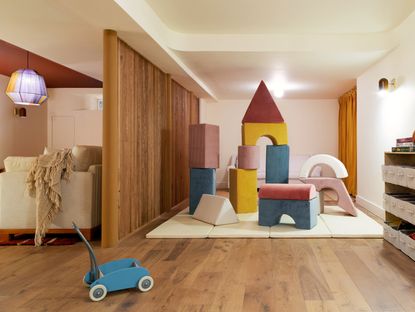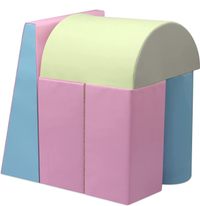This inspired playroom tip might just convince you that your home's layout can change for the better
A playroom designed to squirrel away your kids' stuff behind closed doors might actually be making your home messier, say these designers


Decorating a playroom doesn’t sound like serious business, does it? It’s a room that, in theory, you can go all-in on, making it as riotous, colorful and creative as you (or your kids) desire. But that all hangs on the presumed notion that a playroom is something to be hidden away behind closed doors - a discrete, separate space that children are sent to play in that contains the mess and anything that’s going to be particularly jarring with your home’s ‘grown-up’ decor.
However, enter into a conversation with any interior designer, and you’re likely to quickly discover this set-up is actually less than ideal, for both adults and kids alike. 'The biggest mistake that people make when designing a children's playroom is thinking that they can create a space where children and their toys can be squirreled away,' interior designer Sophie Chapman, an associate at The Vawdrey House, tells us. 'The reality is that children wish to be with their adults in the thick of it, socializing and being seen and heard.' For adults, too, it can be a freeing position for a play area. Playtime supervision becomes something that can be done alongside other tasks and chores.
But how do you feel about including a play area in the main area of your home? If you’re worried about a playroom taking over the adult spaces, you might find that it actually helps keep things properly organized. 'A separate play space away from the heart of the home inevitably means that toys find their way into the key rooms like the kitchen and then have no place to live so inevitably create more clutter and disarray,' Sophie says.

Livingetc's deputy editor Hugh is an experienced homes journalist, with a keen eye for a trend and clever design idea. Tasked with finding the key to a perfect playroom, he discovered this clever advice from several designers.
How do you create a divide between your playroom?

The question, then, becomes about how to create a playroom that lives up to the rest of your home. 'Playspaces don't need to be bright and gaudy, full of primary colors for young curious minds to be active and engaged,' says Reuben Ward, lead designer at Blakes London. At a recent project, Blakes designed a playspace that shared a large open plan room with an adult's cinema and lounge area, which serves as a perfect example. 'By using natural timbers and rich blues we were able to use the same tones and materials in both spaces to create harmony, while still enabling a strong demarcation between the spaces.'
This divide is, however, more than just implied, and this project uses a room divider to help give this room the flexibility to flit between adult and child-friendly space. 'A thick curtain separated the two rooms so that by day when both adults and children were using the space the room seemed to be as one, but at night when the children were in bed, the parents could draw the curtain on the mess and relax in their adult space,' Reuben explains. In another playroom by interior design studio White Arrow, principal designer Keren Richter used a slatted room divider that creates a permanent, physical separation between the den and the playroom, while allowing sightlines into the kids’ space, too.
A physical divide isn’t the answer for every home and, during the re-design process of a home’s layout, the right niche can become the ideal play area. 'In a kitchen area we like to create a nook or a recess that is dedicated to the needs of the younger members of the family,' Sophie from The Vawdrey House explains. Other, subtler, cues can be given to the space, using simple decorating tricks. 'By painting this area in a different color, often a darker tonal shade to the rest of the room, it can be made to feel cocooning and snug.'

Kids soft foam puzzle play set, Amazon
Steal the look of White Arrow's stylish playroom pictured at the top of this article by investing in some soft play blocks.
What else do you need to consider?

Somewhat fortunately, we’ve moved beyond the idea that ‘children should be seen and not heard’, but that doesn’t mean you shouldn’t consider ways to dampen sound from a playroom, especially if it’s opening onto a living room or kitchen, for example. 'On a few projects we have wrapped the recess, both ceiling and walls in acoustic panelling which not only dampens the noise, but also makes the area more welcoming and cozy,' Sophie explains. These panels play a secondary role as well as soundproofing the room. 'Conveniently the acoustic panels double up as pin boards, so childrens artwork, flashcards, family snapshots or even educational posters can easily be pinned to the area for added effect.'
The key to the success of this type of playroom is storage. It’s what’s going to stop every room in your house becoming a dumping ground for toys. 'If toys have a home where they can be hidden away and easily accessed by children, the likelihood of keeping the space neat and tidy is all the greater,' Sophie says. But, not all storage is created equal when it comes to getting kids to put their belongings away.
'We like to have different types of storage within the room,' Reuben from Blakes explains. 'Low level cupboards with shelves works well for items such as board games, but for very young children we like pull out drawers on wheels so that the youngsters can push the draw to the part of the floor space that they are playing in, or ideally tidying up from and can then wheel it back into its place.'
It’s considering these levels that will really make all the difference, whether it’s storage, or just ensuring it’s a space the kids will be happy to contain their playtime to. 'Awkward low level nooks are the perfect area to create a chill out reading zone, for example,' Reuben says. 'And children love to have low level surfaces to play on, so incorporating lower level furniture is always a good idea. Coffee tables make great lego and car driving stations and can always be used long after the children have moved on from lego to gaming.'
Be The First To Know
The Livingetc newsletter is your shortcut to the now and the next in home design. Subscribe today to receive a stunning free 200-page book of the best homes from around the world.

Hugh is the Editor of Livingetc.com. From working on a number of home, design and property publications and websites, including Grand Designs, ICON and specialist kitchen and bathroom magazines, Hugh has developed a passion for modern architecture, impactful interiors and green homes. Whether moonlighting as an interior decorator for private clients or renovating the Victorian terrace in Essex where he lives (DIYing as much of the work as possible), you’ll find that Hugh has an overarching fondness for luxurious minimalism, abstract shapes and all things beige. He’s just finished a kitchen and garden renovation, and has eyes set on a bathroom makeover for 2024.
-
 These 12 Best Table Lamps for Your Desk — Perfect Glows for a Creative Home Office
These 12 Best Table Lamps for Your Desk — Perfect Glows for a Creative Home OfficeThe best table lamps for your desk is have a soft, targeted glow. Elevate your WFH set-up with these stylish picks endorsed by Style Editor Brigid Kennedy
By Brigid Kennedy Published
-
 The Nespresso VertuoPlus is 30% Off for President's Day, and it's Kim Kardashian's Coffee Maker of Choice
The Nespresso VertuoPlus is 30% Off for President's Day, and it's Kim Kardashian's Coffee Maker of ChoiceThis sleek and stylish coffee maker was spotted in Kim's home bar, and you can currently save $60 if you buy yours from Amazon
By Lilith Hudson Published

